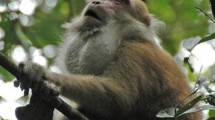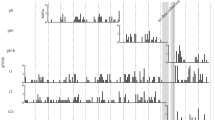Abstract
Quantifying the energy balance is essential for testing socio-ecological models. To reveal costs and benefits of group living in Japanese macaques from the perspective of feeding competition, Kurihara and Hanya (Am J Primatol 77:986–1000, 2015) previously compared feeding behavior between two different-sized groups of macaques (larger group 30–35 individuals; smaller group 13–15 individuals) in the coastal forest of Yakushima, Japan. The results suggested that the larger group exhibited greater feeding effort because of intragroup scramble competition and that the smaller group suffered from higher travel costs, possibly owing to intergroup contest competition. However, it remained unclear whether the behavioral differences affected their energy budgets. The present study examined energetic consequences of the different feeding behaviors in the two groups. Using behavioral data from 10 to 13 adult females and nutritional composition of food items, we compared ingestion rates, energetic/nutritional content of diet, and energy budgets between the two groups. Ingestion rates and energetic/nutritional content of diet did not differ between the two groups. Despite the higher feeding effort of the larger group, energy intake did not differ between the two groups. Energy expenditure did not differ between the two groups because higher travel costs were negated by lower feeding effort in the smaller group. Consequently, the energy balance did not differ between the two groups. We demonstrated that the behavioral measures of feeding competition were not translated into their energetic condition; moreover, our findings re-emphasize the importance of quantifying behavioral and fitness measures for interpreting variation in feeding behavior properly.


Similar content being viewed by others
References
Agetsuma N (1995) Foraging strategies of Yakushima macaques (Macaca fuscata yakui). Int J Primatol 15:595–609
Altizer S, Nunn CL, Thrall PH, Gittleman JL, Antonovics J, Cunningham AA, Dubson AP, Ezenwa V, Jones KE, Pedersen AB, Poss M, Pulliam JRC (2003) Social organization and parasite risk in mammals: integrating theory and empirical studies. Annu Rev Ecol Evol Syst 34:517–547
Chapman CA, Chapman LJ (2000) Determinants of group size in primates; the importance of travel costs. In: Boinski S, Garber PA (eds) On the move: how and why animals travel in groups. University of Chicago Press, Chicago, pp 24–42
Chapman CA, Chapman LJ, Rode KD, Hauck EM, McDowell LR (2003) Variation in the nutritional value of primate foods: among trees, time periods, and areas. Int J Primatol 24:317–333
Chapman CA, Rothman JM, Lambert JE (2012) Food as a selective force in primates. In: Mitani J, Call J, Kappeler P, Palombit R, Silk J (eds) The evolution of primate societies. University of Chicago Press, Chicago, pp 149–168
Cheney DL, Seyfarth RM (1987) The influence of intergroup competition on the survival and reproduction of female vervet monkeys. Behav Ecol Sociobiol 21:375–386
Crofoot MC (2013) The cost of defeat: capuchin groups travel further, faster and later after losing conflicts with neighbors. Am J Phys Anthropol 152:79–85
Crofoot MC, Gilby IC, Wikelski MC, Kays RW (2008) Interaction location outweighs the competitive advantage of numerical superiority in Cebus capucinus intergroup contests. Proc Natl Acad Sci USA 105:577–581
Dunbar RIM (1988) Primate social systems. Chapman & Hall, London
Dunn JC, Cristóbal-Azkarate J, Schulte-Herbrüggen B, Chavira R, Veà JJ (2013) Travel time predicts fecal glucocorticoid levels in free-ranging howlers (Alouatta palliata). Int J Primatol 34:246–259
Fan PF, Garber PA, Ma C, Ren GP, Liu CM, Chen XY, Yang JX (2015) High dietary diversity supports large group size in Indo-Chinese gray langurs in Wuliangshan, Yunnan, China. Am J Primatol 77:479–491
Fooden J, Aimi M (2005) Systematic review of Japanese macaques, Macaca fuscata (Gray, 1870). Fieldiana Zool 104:1–198
Girard-Buttoz C, Higham JP, Heistermann M, Wedegärtner S, Maestripieri D, Engelhardt A (2011) Urinary C-peptide measurement as a marker of nutritional status in macaques. PLoS One 6:e18042
Gogarten JF, Bonnell TR, Brown LM, Campenni M, Wasserman MD, Chapman CA (2014) Increasing group size alters behavior of a folivorous primate. Int J Primatol 35:590–608
Grueter CC, Robbins AM, Abavandimwe D, Vecellio V, Ndagijimana F, Ortmann S, Stoinski TS, Robbins MM (2016) Causes, mechanisms, and consequences of contest competition among female mountain gorillas in Rwanda. Behav Ecol 27:766–776
Hamilton WD (1971) Geometry for the selfish herd. J Theor Biol 31:295–311
Hanya G (2014) Japanese Macaques: habitat-driven divergence in social dynamics. In: Yamagiwa J, Karczmarski L (eds) Primates and cetaceans. Springer, Tokyo, pp 99–114
Hanya G, Fuse M, Aiba SI, Takafumi H, Tsujino R, Agetsuma N, Chapman CA (2014) Ecosystem impacts of folivory and frugivory by Japanese macaques in two temperate forests in Yakushima. Am J Primatol 76:596–607
Iwamoto T (1988) Food and energetics of provisioned wild Japanese macaques Macaca fuscata. In: Fa JE, Southwick CH (eds) Ecology and behavior of food-enhanced primate groups. Liss, New York, pp 79–94
Janson CH (1988) Food competition in brown capuchin monkeys (Cebus apella): quantitative effects of group size and tree productivity. Behaviour 105:53–76
Janson CH, Goldsmith ML (1995) Predicting group size in primates: foraging costs and predation risks. Behav Ecol 6:326–336
Janson CH, van Schaik CP (1988) Recognizing the many faces of primate food competition: methods. Behaviour 105:165–186
Key C, Ross C (1999) Sex differences in energy expenditure in non-human primates. Proc R Soc B 266:2479–2485
Kleiber M (1961) The fire of life: an introduction to animal energetics. Wiley, New York
Koenig A (2002) Competition for resources and its behavioral consequences among female primates. Int J Primatol 23:759–783
Koenig A, Borries C (2009) The lost dream of ecological determinism: time to say goodbye? … Or a white queen’s proposal? Evol Anthropol 18:166–174
Kurihara Y, Hanya G (2015) Comparison of feeding behavior between two different-sized groups of Japanese macaques (Macaca fuscata yakui). Am J Primatol 77:986–1000
Lambert JE, Rothman JM (2015) Fallback foods, optimal diets, and nutritional targets: primate responses to varying food availability and quality. Annu Rev Anthropol 44:493–512
Leonard WR, Robertson ML (1997) Comparative primate energetics and hominid evolution. Am J Phys Anthropol 102:265–281
Majolo B, de Bortoli Vizioli A, Schino G (2008) Costs and benefits of group living in primates: group size effects on behaviour and demography. Anim Behav 76:1235–1247
Nagy KA, Milton K (1979) Energy metabolism and food consumption by wild howler monkeys (Alouatta palliata). Ecology 60:475–480
Nakagawa N (1989) Bioenergetics of Japanese monkeys (Macaca fuscata) on Kinkazan Island during winter. Primates 30:441–460
Nakagawa N (1997) Determinants of the dramatic seasonal changes in the intake of energy and protein by Japanese monkeys in a cool temperate forest. Am J Primatol 41:267–288
Nakagawa N, Iwamoto T, Yokota N, Soumah AG (1996) Inter-regional and inter-seasonal variations of food quality in Japanese macaques: constraints of digestive volume and feeding time. In: Fa JE, Lindburg DG (eds) Evolution and ecology of macaque societies. Cambridge University Press, Cambridge, pp 207–234
National Research Council (2003) Nutrient requirements of nonhuman primates. National Academy Press, Washington DC
Otani T, Agetsuma N, Agetsuma-Yanagihara Y (2007) History of forest utilization in the World Natural Heritage Area of western Yakushima lsland. Jpn J Conserv Ecol 12:78–85 (Japanese with English abstract)
Rothman JM, Chapman CA, Soest PJ (2012) Methods in primate nutritional ecology: a user’s guide. Int J Primatol 33:542–566
Saito C, Sato S, Suzuki S, Sugiura H, Agetsuma N, Takahata Y, Sasaki C, Takahashi H, Tanaka T, Yamagiwa J (1998) Aggressive intergroup encounters in two populations of Japanese macaques (Macaca fuscata). Primates 39:303–312
Sanderson CE, Jobbins SE, Alexander KA (2014) With Allee effects, life for the social carnivore is complicated. Popul Ecol 56:417–425
Sawada A, Sakaguchi E, Hanya G (2011) Digesta passage time, digestibility, and total gut fill in captive Japanese macaques (Macaca fuscata): effects of food type and food intake level. Int J Primatol 32:390–405
Schaebs FS, Wolf TE, Behringer V, Deschner T (2016) Fecal thyroid hormones allow for the noninvasive monitoring of energy intake in capuchin monkeys. J Endocrinol 231:1–10
Snaith TV, Chapman CA (2008) Red colobus monkeys display alternative behavioral responses to the costs of scramble competition. Behav Ecol 19:1289–1296
Soxhlet FV (1879) Die gewichtsanalytische bestimmung des milchfettes. Polytechnisches J 232:461–465
Stacey PB (1986) Group size and foraging efficiency in yellow baboons. Behav Ecol Sociobiol 18:175–187
Sterck EH, Watts DP, van Schaik CP (1997) The evolution of female social relationships in nonhuman primates. Behav Ecol Sociobiol 41:291–309
Sugiura H, Saito C, Sato S, Agetsuma N, Takahashi H, Tanaka T, Furuichi T, Takahata Y (2000) Variation in intergroup encounters in two populations of Japanese macaques. Int J Primatol 21:519–535
Taylor CR, Schmidt-Nielsen K, Raab JL (1970) Scaling of energetic cost of running to body size in mammals. Am J Physiol 219:1104–1107
Tsuji Y, Takatsuki S (2012) Interannual variation in nut abundance is related to agonistic interactions of foraging female Japanese macaques (Macaca fuscata). Int J Primatol 33:489–512
Tsujino R, Yumoto T (2007) Spatial distribution patterns of trees at different life stages in a warm temperate forest. J Plant Res 120:687–695
Tucker VA (1970) Energetic cost of locomotion in animals. Comp Biochem Phys 34:841–846
van Schaik CP, van Noordwijk MA, de Boer RJ, den Tonkelaar I (1983) The effect of group size on time budgets and social behaviour in wild long-tailed macaques (Macaca fascicularis). Behav Ecol Sociobiol 13:173–181
van Soest PV, Robertson J, Lewis B (1991) Methods for dietary fiber, neutral detergent fiber, and nonstarch polysaccharides in relation to animal nutrition. J Dairy Sci 74:3583–3597
Worton BJ (1989) Kernel methods for estimating the utilization distribution in home-range studies. Ecology 70:164–168
Wrangham RW (1980) An ecological model of female-bonded primate groups. Behaviour 75:262–300
Zuur AF, Ieno EN, Walker NJ, Saveliev AA, Smith GM (2009) Mixed effects models and extensions in ecology with R. Springer, New York
Acknowledgements
We thank the Yakushima Forest Ecosystem Conservation Center and Kagoshima Prefectural Government for their permission to conduct behavioral data collection in Yakushima. We would like to express our gratitude to Drs. Hideki Sugiura and Mariko Suzuki for his warm support in the field, Mr. Toshihiro Saito for his help in identifying plant species, Dr. Akiko Sawada and Ms. Yuki Shima for helping with food sample collection, and Dr. Shota Mochizuki for helping with the GPS data analysis. We are grateful to the members of the Department of Ecology and Social Behavior in the Primate Research Institute in Kyoto University for giving us constructive comments and suggestions. This study was supported financially by the Cooperation Research Program of the Wildlife Research Center, Kyoto University, Daiko Foundation Scholarship, and Grant-in-Aid for JSPS Research Fellow (No. 16J01208) to YK and Grant-in-Aid for Scientific Research (B) from the Japan Society for the Promotion of Science (No. 23370099 to Dr. Naofumi Nakagawa, the Laboratory of Human Evolution Studies, Graduate School of Science, Kyoto University).
Author information
Authors and Affiliations
Corresponding author
About this article
Cite this article
Kurihara, Y., Hanya, G. Comparison of energy balance between two different-sized groups of Japanese macaques (Macaca fuscata yakui). Primates 58, 413–422 (2017). https://doi.org/10.1007/s10329-017-0607-x
Received:
Accepted:
Published:
Issue Date:
DOI: https://doi.org/10.1007/s10329-017-0607-x




